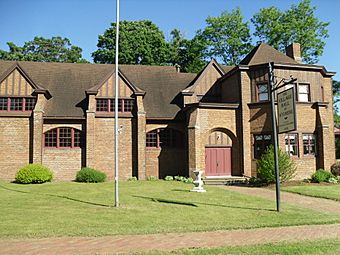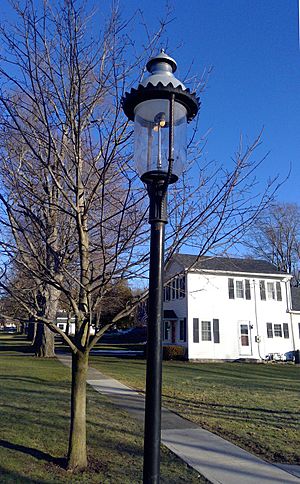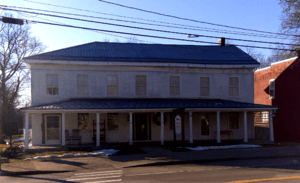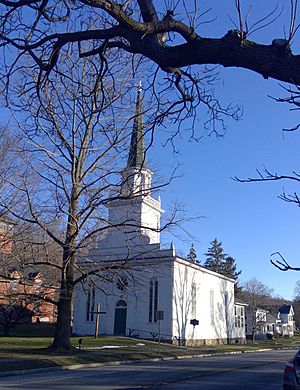Wyoming Village Historic District (Wyoming, New York) facts for kids
Quick facts for kids |
|
|
Wyoming Village Historic District
|
|

Wyoming Village Hall, May 2010
|
|
| Location | NY 19, Wyoming, New York |
|---|---|
| Area | 45 acres (18 ha) |
| Architectural style | Greek Revival, Federal |
| NRHP reference No. | 74001326 |
| Added to NRHP | December 27, 1974 |
The Wyoming Village Historic District is a special area in Wyoming Village, New York. It covers about 45 acres (18 hectares) and looks like an old New England village. It's built around a small, triangle-shaped park called a village green. This T-shaped district has about 72 old buildings along its two main streets: Main Street and Academy Street.
This historic district is important for its architecture, education, community history, and how the town was planned. You can see many different building styles here, like Greek Revival, Victorian, Colonial Revival, Gothic, and French Provincial. Most of the houses in the district were built in the early to mid-1800s. They were often built by local workers, shop owners, and farmers who had retired. Maple Street has two rows of old maple trees that stand tall among the simple houses.
Some of the most important buildings in the district are the Presbyterian Church (built in 1830), the Fire Tower (1902), the Wyoming Inn (1838), the Bryant Fleming House (1910), and the Village Hall (1902). The historic Middlebury Academy is also a very old building that is listed separately as a historic place.
Contents
What Makes the District Special?
The Wyoming Village Historic District is set up like a classic New England village. It has a small, triangle-shaped green (a grassy park area) at its center. The district is shaped like a "T" and includes about 70 buildings along its two main roads: Main Street and Academy Street.
The most important buildings are grouped around the triangular green. These include the Wyoming Inn (built in 1838), an old bank, several stores, the village "Fire Tower," and the Presbyterian Church.
Wyoming Village is known as "The Gaslight Village." This is because 30 gas lamps light up the village day and night. These lamps use natural gas from nearby underground pockets, thanks to a special 99-year agreement.
Building Styles You Can See
Federal Style Buildings
Many houses in the district show the Federal style of architecture. These homes are usually two stories tall and made of wood. They often have a main door in the center, five windows across the front, and usually one window on the sides. Some great examples of this style include:
- The Newell-Bradley-Bishop House at 73 Main Street.
- The Dillon House at 14 South Academy Street.
- The Cushing-Hooker House at 30 South Academy Street.
- The Chad Ewell-Squires House at 31 Main Street.
The most important building on the village green is the Presbyterian Church. This tall, white church with a steeple is a good example of how New England churches were built in western New York. It's a large wooden building finished in 1830. It has some Federal features, like a simple front door and a fanlight (a window shaped like a fan). The inside of the church was updated in 1852, and its tall spire was rebuilt in 1870.
Greek Revival Style Buildings
The Middlebury Academy, built in 1817, is famous for its large Greek Revival front porch. This porch was likely added a few years after the building was first completed. Other parts of the building still show the Federal style.
Two other buildings in the district also have strong Greek Revival features:
- The Ferris-Arnold House at 6 North Academy Street. This is a one-and-a-half-story wooden house built on a very tall basement. It has special wooden siding that looks like stone blocks. The front door has side windows and a window above it. There's a high front porch with columns and a railing along the roof. Inside, some wallpaper shows scenes from old novels. The house still has formal gardens on its south side.
- The Dodson-Swanson House at 36 Main Street. This is a large two-story house with a wide porch in the center. The porch has four columns. The side parts of the house were probably made taller in the late 1800s or early 1900s.
Interesting and Unique Buildings
Here are some of the unique buildings from the mid-1800s when Wyoming Village was growing:
- The Seaver-Trumpfheller House at 14 North Academy Street. This is a two-and-a-half-story wooden house with a unique, uneven shape. It has fancy Victorian decorations around the windows and on the entrance porch.
- 46 Main Street was once the first schoolhouse in Wyoming. Since 1916, it has been a farm supply and hardware store run by the Handyside family. It's a simple, one-story building with narrow wooden siding, three windows wide, a simple doorway, and a roof with a large overhang. It also has a small tower with vents on top.
- The Ianella-Dutton House at 32 Main Street. This is a two-story wooden house with beautiful wooden details on its porches and gables, similar to the house at 14 North Academy Street.
- The Warren-Main House at 31 South Academy. This is a one-and-a-half-story cottage with a special board-and-batten siding and Gothic decorations on the gables. A Colonial Revival style porch was added in the early 1900s.
- The two churches on Main Street both burned down in the late 1800s. The Baptists rebuilt their church at 28 Main Street with a strong brick building around 1876. The Methodist Church at 16 Main Street was built in 1893. It's a wooden building with Gothic details, pointed decorations, and pointed windows.
- The Fire Tower on Tower Road is a one-and-a-half-story brick building with a very steep, pagoda-like roof. It was built in 1902 as the village fire station. It was a gift to the community from the Lydia Avery Coonley-Ward family, who lived nearby. The tower was updated in the 1990s with a German clock.
- The Village Hall on Academy Street is a brick building with French provincial architecture. It was also built in 1902 as a gift from the Lydia Avery Coonley-Ward family. They wanted it to be a community center for arts and sciences. The first floor has a lobby, clubroom, kitchen, and a large assembly room. This assembly room is two stories tall and has a stage. The stage's archway has special black teak wood that was once part of the King of Siam's display at the 1893 World's Columbian Exposition in Chicago. Upstairs, there's a small museum with a collection of natural history items from 1902–1906. The Village Hall grounds include about 3 acres with old trees and a stream.
- Middlebury Academy on Academy Street was a school that prepared boys for college.
Where to Find Buildings in the District
Here's a list of some of the buildings within the Wyoming Village Historic District:
South Academy Street
- East side – 4, 8, 14, 18, 22 (Middlebury Academy), 28, 30, 32, 42, 46.
- West side – 1 (Wyoming Inn), 5, 15 (Village Hall), 25, 31, 33, 37.
North Academy Street
- 1 (Presbyterian Church), 2, 6, 14.
Main Street
- North side – 3, 7, 11, 15, 21, 25, 31, 35, 37, 45, 47, 49, 51, 57, 59, 63, 65, 69, 73, 79, 83.
- South side – 6, 8, 16 (Methodist Church), 20, 22, 26, 28 (1st Baptist Church), 30, 32, 36, 40, 42, 46, 50, 52, 54, 56, 58, 60, 64, 66.
Tower Road
- 3, 10 (Fire Tower).
Gulf Road
- 2, 7, 11, 18.







